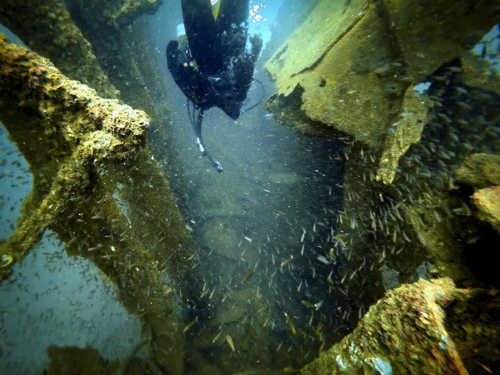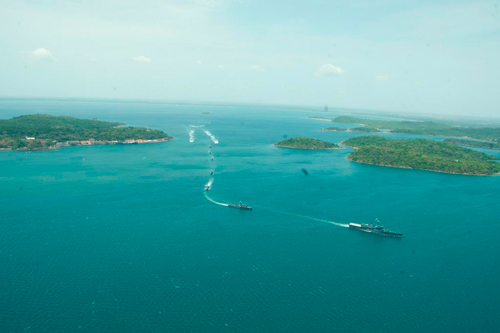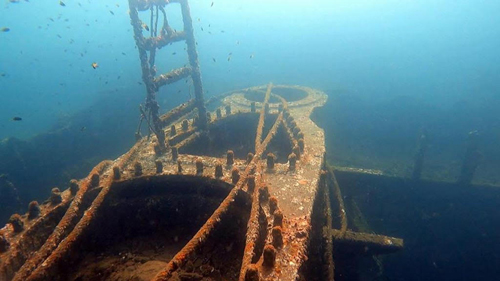Dive into Trinco’s treasure trove beneath the waves
Trincomalee is not only a hidden gem that offers a unique blend of ancient history and natural beauty, but also a unique world-class dive site with its beautiful reef, shipwrecks and diverse marine life. Promotion of recreational diving in Trincomalee harbour is timely. Despite being located in naval premises, the Trincomalee harbour has a great potential to entice diving enthusiasts to explore Trincomalee beneath the waves, accompanied by naval divers.
 The eastern seaboard that extends over 300 km is of unparalleled beauty and the adjoining seas endowed with beautiful reefs, shipwrecks and marine life are a paradise for diving attracting many foreigners and diving enthusiasts. The virgin reef surrounding Pigeon Island is one of the country’s marine protected areas.
The eastern seaboard that extends over 300 km is of unparalleled beauty and the adjoining seas endowed with beautiful reefs, shipwrecks and marine life are a paradise for diving attracting many foreigners and diving enthusiasts. The virgin reef surrounding Pigeon Island is one of the country’s marine protected areas.
The treasure trove in the majestic harbour has welcomed mariners of the East and the West since ancient times. The deep-water natural harbour has drawn seafarers like Marco Polo, Ptolemy, and merchants from China, East Asia, and Arabia. The harbour has been a seaport since the days of the ancient Sri Lankan Kings. The Mahavamsa contains the oldest known mention of the port of Gokanna as Trincomalee was then known, describing Panduvasdeva, King Vijaya’s nephew, arriving at Gokanna in the fifth century BC to assume the throne of Lanka.
The port of Trincomalee had been a centre of attraction in European geopolitical conflicts between the English, Dutch and French. In addition to its advantageous position, the harbour served a unique purpose for seafarers during the age of the sail. With a deep, narrow inlet and a low-lying landscape on either side, Orlando Cove on Sober Island provided the perfect place for a ship that was careening.
Historic shipwrecks including HMS Diomede that foundered in the British landing of Trincomalee in 1795 and maritime remnants such as cannons and anchors are unquestionably heritage dive sites. Numerous artifacts from the British occupation of the harbour during World War II attest to its crucial maritime strategic importance at the time. Having bombed Colombo on April 5, 1942, the Japanese raided Trincomalee on April 9, resulting in the sinking of the HMS Hermes and her escort HMAS Vampire south of Trincomalee. Underwater sites of this epoch are the grand floating dock AFD 23, aircraft wrecks debris disposed by fleet air arm station, sites of ordnance disposal and SS Sagaing, a 7996 ton steam ship.

Trinco harbour: A historic port home to many wrecks
Admiralty Floating
Dock 23 (AFD 23)
AFD 23 was built in Bombay and upon completion in July 1944, was towed to Trincomalee and moored off Sober Island to dock allied warships during World War II. One of the largest ship wrecks in the world, the 50,000 ton AFD 23 sank on August 8, 1944 when buoyancy had failed while the 30,000 ton battleship HMS Valiant was in dock. Only half of this wreck now remains at its final resting place in the Trincomalee harbour as the collapsed rear half was later salvaged for scrap iron. It had been a soaring site in the middle of the harbour until 1971 with one of the crane towers that remained above water and that part was re-floated later. Today, the remaining part of the dock stays majestically resting at 140 feet at the bottom, the upper decks of the side walls at 80 feet. AFD 23 could be the second best wreck dive after the Hermes wreck off Batticaloa. The upper decks on the side walls contain many compartments that were possibly work stations and machinery spaces and the deck tops still hold numerous glasspane pan lights that allowed sunlight into the space beneath.
HMS Diomede
At 140 feet, in the cold and gloomy waters in the middle of the Back Bay lies a historic wreck, the British Frigate that met its fate during the landing to capture Trincomalee’s Ostenburg Fort from the Dutch. HMS Diomede was a 44-gun fifth-rate built by James Martin Hillhouse, launched at Bristol on October 18, 1781. She belonged to the Roebuck class of vessels especially built during the American Revolutionary War for service in the shallow American coastal waters.
 HMS Diomede, sailing under the command of Captain Matthew Smith, had arrived off Trincomalee in late July 1795 along with Suffolk, Hobart, Centurion, and troop-transports, under the flag of Rear Admiral Peter Rainier who was commanding His Majesty’s ships in the East Indies with orders to conquer Trincomalee and other Dutch settlements on the island. On August 30, 1795, Diomede had foundered having struck an uncharted rock in the bay while heading to shore with a heavy sailing vessel in tow. Even today, a few of her 9 pounder and 18 pounder guns are visible along with some iron work and deck fittings. Though ostensibly all of her wooden structure has deteriorated with time, a thorough archaeological investigation of the shipwreck would disclose many details.
HMS Diomede, sailing under the command of Captain Matthew Smith, had arrived off Trincomalee in late July 1795 along with Suffolk, Hobart, Centurion, and troop-transports, under the flag of Rear Admiral Peter Rainier who was commanding His Majesty’s ships in the East Indies with orders to conquer Trincomalee and other Dutch settlements on the island. On August 30, 1795, Diomede had foundered having struck an uncharted rock in the bay while heading to shore with a heavy sailing vessel in tow. Even today, a few of her 9 pounder and 18 pounder guns are visible along with some iron work and deck fittings. Though ostensibly all of her wooden structure has deteriorated with time, a thorough archaeological investigation of the shipwreck would disclose many details.
Aircraft wrecks
The East Indies Fleet operating from Ceylon for most part of the World War II later became the Eastern Fleet at the end of March 1942 with the arrival of Admiral Somerville. As a result, more air squadrons had been flown in to the island and were mostly operating with aircraft carriers. More often than not carrier escorts had been provided for east and west-bound convoys in the Indian Ocean.
In Trincomalee, HMS Bambara was the fleet air arm station situated at present-day China Bay Air Force base. The Clappenburg Wharf was purposefully built to facilitate transfer of damaged and repair bound aircraft to adjoining repair workshops from aircraft carriers. Eventually, unrepairable aircraft and cannibalised parts ended up in the deep seas off Round Island, and there exists a fascinating dive site that recalls wartime air operations.
There was a wide belief that these aircraft were famous Mitsubishi A6M, popularly known as the ‘Zero’ dive bombers that had been downed during the 1942 raid. This is now found to be false. None of the wrecks resemble the famous aircraft and sufficient documentary evidence prevails to prove that they are in fact aircraft dumped by the fleet air arm.
SS Sagaing
The 138m passenger cargo ship SS Sagaing launched on December 24, 1924, was hit by Japanese carrier aircraft bomber attacks whilst at anchorage in the Trincomalee harbour on April 9th, 1942. On August 24, 1943, the damaged vessel was deliberately sunk to create a pier for naval ships. On March 22, 2018, the Sri Lanka Navy refloated the wreck which was fully submerged in order to make room for expanding berthing facilities in the harbour, the project having got off the ground on September 11, 2017. It was sunk again in the sea area of Elephant Point and Elephant Island.
Ships scuttled to create
artificial reef
Trincomalee harbour is home to a few wrecks of the contemporary era; the graveyard of the Navy’s decommissioned ships. Two Chinese fast gunboats, ex Rakshaka and Dhakshya rest at Middle Ridge along with a small tug boat. More recently, the Navy set destination for their decommissioned ships ex-Weeraya and Jagatha off the Rocky Point in 2020. For adventurous divers, these sites are the ultimate playground, where they can discover hidden treasures and unravel the secrets of the deep.
Although visibility varies periodically due to monsoonal rainfall and Mahaweli waters mixing with the sea at its three prone estuaries on the southern coast front of the harbour, diving in Trincomalee harbour is possible all year long.
Wreck diving is quite adventurous as murkily dark sights of these wrecks encrusted with barnacles suddenly appear before the diver as he/she reaches the bottom. Occasionally, a very fortunate diver may hear whale hums and encounter a friendly whale shark lurking nearby as they frequent the harbour seasonally.
(The writer is Commander of the Sri Lanka Navy)
Searching for an ideal partner? Find your soul mate on Hitad.lk, Sri Lanka's favourite marriage proposals page. With Hitad.lk matrimonial advertisements you have access to thousands of ads from potential suitors who are looking for someone just like you.


